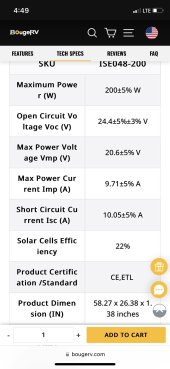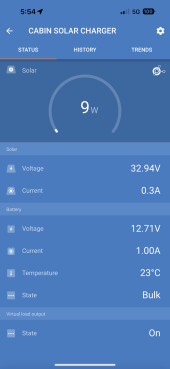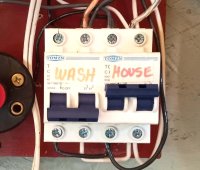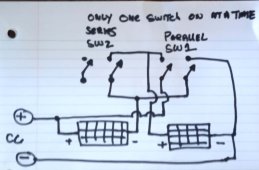I have solar panels flat mounted on the roof of my vehicle. I travel the country full time, which means I am in a wide variety of environments, from full sun to partial shade to mostly shade with just a little sun filtering through trees. I don’t want to change the panel configuration continually, since my vehicle is very tall and I move fairly quickly from one place to another - I’m not really nesting in one area for any predictable length of time. I want to set the panels up in whatever way is going to give me, on average, the best performance in whatever circumstance I happen to be temporarily experiencing.
I’ve been doing this for four years and I have always had my panels connected in parallel in the past, because my understanding was that, when I am in partial shade, it will have a significant effect on the performance of a series array. But recently, I was convinced by someone who is more experienced than me that I will get better performance overall from a series connection. Only problem is, he can’t seem to explain WHY, just says “trust me.” Well, I am someone who really likes to know why. So… why? I understand that higher voltage is “better” but I’m not sure WHY it’s better. I understand that if the voltage is too low I can’t charge the battery. But series or parallel, the voltage is not going to be too low. So why, in plain English, is less watts and more volts better?
Let’s say I am charging a 2000 WH all-in-one device that has an MPPT controller built in, rated for up to 150v of solar, and I have (2) 200w panels (18v vmp) available to charge it. If I connect them in parallel, I’ve got 400w going in to the device at 18v, and If I connect them in series I have 200w going in at 36v… right? So why is the higher voltage better? Both voltages are adequate for charging, so why is series going to give me better performance overall? I know this is probably a stupid beginner basic question but I cannot seem to get an answer that actually satisfies me.
And also… what really does happen to that series array when it’s partially shaded? Is it less drastic than I always believed? Has something changed in solar panel technology in the 5 years I’ve been using a parallel connection?
I’ve been doing this for four years and I have always had my panels connected in parallel in the past, because my understanding was that, when I am in partial shade, it will have a significant effect on the performance of a series array. But recently, I was convinced by someone who is more experienced than me that I will get better performance overall from a series connection. Only problem is, he can’t seem to explain WHY, just says “trust me.” Well, I am someone who really likes to know why. So… why? I understand that higher voltage is “better” but I’m not sure WHY it’s better. I understand that if the voltage is too low I can’t charge the battery. But series or parallel, the voltage is not going to be too low. So why, in plain English, is less watts and more volts better?
Let’s say I am charging a 2000 WH all-in-one device that has an MPPT controller built in, rated for up to 150v of solar, and I have (2) 200w panels (18v vmp) available to charge it. If I connect them in parallel, I’ve got 400w going in to the device at 18v, and If I connect them in series I have 200w going in at 36v… right? So why is the higher voltage better? Both voltages are adequate for charging, so why is series going to give me better performance overall? I know this is probably a stupid beginner basic question but I cannot seem to get an answer that actually satisfies me.
And also… what really does happen to that series array when it’s partially shaded? Is it less drastic than I always believed? Has something changed in solar panel technology in the 5 years I’ve been using a parallel connection?
Last edited:








